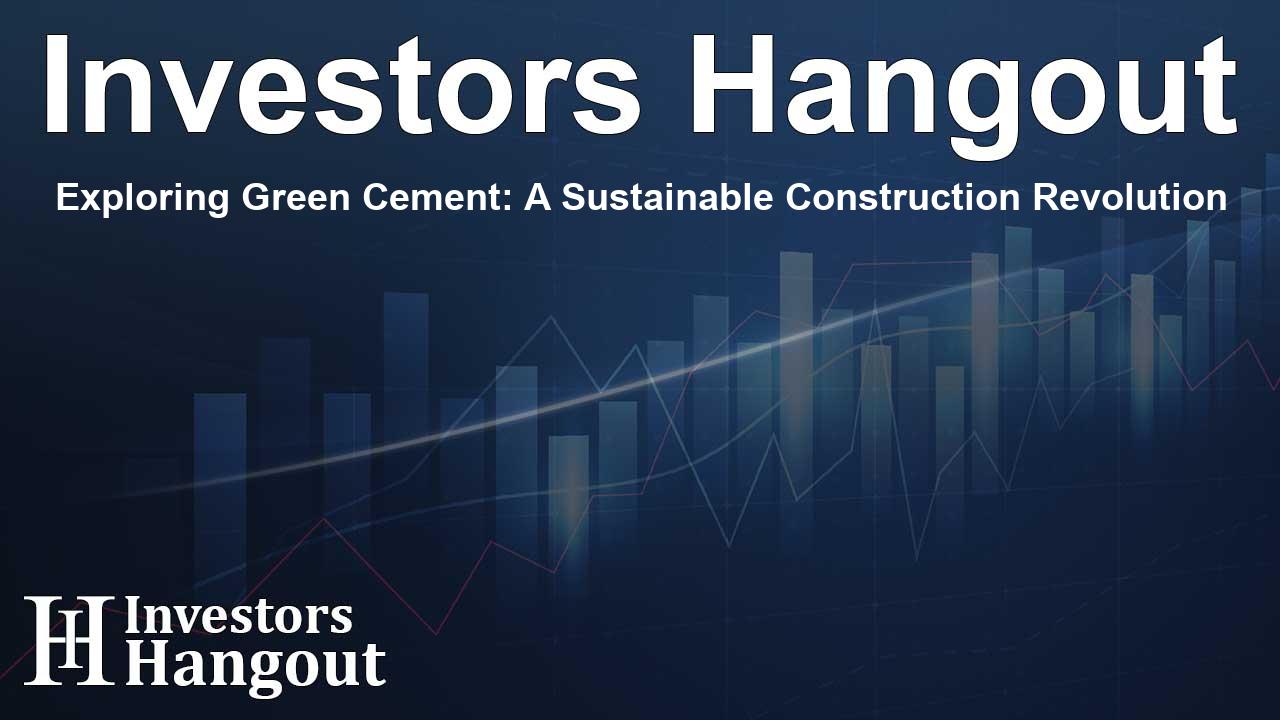Exploring Green Cement: A Sustainable Construction Revolution

The Rise of Green Cement in Sustainable Construction
As the world shifts towards more sustainable practices, the green cement market is poised for remarkable growth, with forecasts estimating a rise from USD 38.19 billion in 2024 to an impressive USD 69.37 billion by 2034. This growth signifies a compound annual growth rate (CAGR) of approximately 6.15% during the upcoming years. The ongoing quest for eco-friendly construction materials that minimize carbon footprints greatly contributes to this trend.
Understanding Green Cement
Green cement represents a revolutionary evolution in cement production, utilizing alternative raw materials and innovative technologies. Unlike traditional Portland cement, green cement is designed to significantly lower carbon emissions while maintaining, or even enhancing, structural performance. It typically incorporates industrial by-products such as fly ash, slag, and silica fume, advancing environmental sustainability through resource recycling.
Driving Factors for Market Growth
The burgeoning green cement market is primarily driven by stricter environmental regulations and an urgent demand for sustainable construction practices. With more developers acknowledging their sustainability roles, the construction industry calls for innovative materials that meet eco-friendly standards. Among the major players, Asia Pacific has emerged as a frontline leader, propelled by rapid urbanization and significant infrastructure developments.
Market Overview: Trends and Innovations
In recent years, various segments within the green cement market have received focused innovations. For example, the growing utilization of alternative fuels and biomass instead of conventional fossil fuels has made cement production more sustainable and economical. The incorporation of materials like industrial by-products helps reduce production costs and energy consumption, which in turn drives green cement's competitive edge.
Market Segmentation and Usage
Analyses show that the building and construction sector remains the largest consumer of green cement, holding a dominant market share. Government-backed public projects are anticipated to further enhance the demand for eco-friendly materials. The increased interest in urban infrastructure enhancements and residential development continues to support this growing market.
Advantages of Green Cement
Green cement offers a plethora of benefits that advocate its use over traditional cement. Firstly, its production process captures and utilizes waste products, resulting in reduced environmental impacts. Importantly, the carbon footprint associated with green cement production can be up to 80% less than that of traditional cement manufacturing. Furthermore, its durability and resistance to corrosion make it ideal for use in diverse construction applications, ranging from building pathways to bridges.
The Future of Green Cement
The future of green cement is closely tied to innovations and research outcomes regarding low-carbon products. Technologies focusing on carbon capture and utilization are being explored, paving the way for long-term solutions to cement's impact on climate change. Investment in next-generation cement types, along with government incentives fostering eco-friendly construction methods, will propel market growth in the coming decade.
Challenges and Opportunities Ahead
Despite the myriad advantages of green cement, the industry faces challenges such as higher production costs associated with advanced materials. Moreover, the availability of key supplementary raw materials remains a concern as reliance on traditional power sources diminishes due to cleaner energy policies. However, alongside these challenges lies an abundance of opportunities—ranging from heightened government mandates on sustainability to an industry increasingly invested in environmentally responsible practices.
Key Industry Players
This growing segment of the construction sector includes several major players known for their commitment to sustainability, including companies that specialize in implementing eco-friendly practices. Collaborations among these companies can be expected to drive both innovations and competitive advantages in the green cement landscape.
Frequently Asked Questions
What is green cement?
Green cement is an eco-friendly alternative to traditional cement, made using sustainable materials that reduce carbon emissions during production.
Why is the green cement market growing?
The market is expanding due to rising environmental regulations, increased demand for sustainable construction materials, and innovations in production technologies.
What are the main benefits of using green cement?
Benefits include lower carbon emissions, cost-effectiveness, high durability, and the utilization of waste materials in its production.
Which sectors are the biggest consumers of green cement?
The building and construction sector is the leading consumer, especially in government and infrastructure projects.
What future innovations might influence the green cement market?
Innovations in carbon capture, new low-carbon product developments, and the increased use of alternative fuels are expected to shape the market's future.
About The Author
Contact Riley Hayes privately here. Or send an email with ATTN: Riley Hayes as the subject to contact@investorshangout.com.
About Investors Hangout
Investors Hangout is a leading online stock forum for financial discussion and learning, offering a wide range of free tools and resources. It draws in traders of all levels, who exchange market knowledge, investigate trading tactics, and keep an eye on industry developments in real time. Featuring financial articles, stock message boards, quotes, charts, company profiles, and live news updates. Through cooperative learning and a wealth of informational resources, it helps users from novices creating their first portfolios to experts honing their techniques. Join Investors Hangout today: https://investorshangout.com/
The content of this article is based on factual, publicly available information and does not represent legal, financial, or investment advice. Investors Hangout does not offer financial advice, and the author is not a licensed financial advisor. Consult a qualified advisor before making any financial or investment decisions based on this article. This article should not be considered advice to purchase, sell, or hold any securities or other investments. If any of the material provided here is inaccurate, please contact us for corrections.
